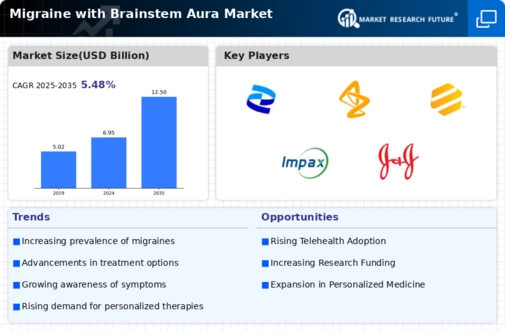Market Trends
Key Emerging Trends in the Migraine Brainstem Aura Market
As individuals understand more about migraine with brainstem aura, neurology research advances, and individualized treatment strategies are developed, migraine market trends are evolving. Basilar migraine, commonly known as migraine with brainstem aura, causes brainstem nerve signals. These include vision, balance, speech, and dizzy issues. The market is become aware of this migraine's differences. Since diagnostic criteria have evolved and clinicians are more aware of brainstem aura migraines, they are simpler to identify. This enhanced understanding ensures that these symptoms are diagnosed and treated properly. Markets are shifting toward brainstem aura-specific migraine treatments. Developing novel migraine medications that target this type's neurological symptoms is becoming more crucial. Brainstem aura migraines are getting personalized therapies as research continues. Pharmaceutical firms are developing brain-targeted migraine medications to give more effective and symptom-specific treatment. Neurology and headache specialists are increasingly needed to treat brainstem aura migraines. These doctors comprehend the cerebral elements of the illness, ensuring full, multidisciplinary treatment. New imaging approaches including functional MRI and PET scans can diagnose migraines with brainstem aura episodes. These advances help us understand the fundamental brain, which may inform treatment. Due to the trend toward individualized medication, migraine with brainstem aura is being treated individually. Because patients' symptoms vary, personalized treatment regimens are becoming increasingly prevalent. Patient support organizations and training initiatives help spread awareness about brainstem aura migraines. Understanding their ailment, treatment options, and lifestyle changes may help individuals improve their health. Telemedicine is being used to treat brainstem aura migraines, particularly for neurology consultations. This trend makes professional treatment simpler to get. Patients may now get timely advice from healthcare professionals from home. Pharmaceutical businesses, research institutes, and healthcare personnel are collaborating to understand and treat brainstem aura migraines. Information and resource sharing accelerates therapy development. Even while things are improving, brainstem aura migraine therapies are still expensive. The market is progressively solving these issues by making drugs more inexpensive and covered by more insurance plans so more individuals can obtain effective treatment. The market for brainstem aura migraines will undoubtedly rise as more is discovered about their complexity. Thanks to personalized therapy, increased awareness, and stakeholder collaboration, migraine and brainstem aura sufferers could have a brighter future.








Leave a Comment